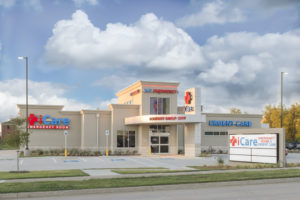Our partners from iCare Emergency Room & Urgent Care sponsored and crafted this blog post on the major differences among urgent care and emergency facilities.
Let’s say your child has a high fever, things are getting worse, and you need quick medical attention. Where do you go?
If you take your child to urgent care, your provider might suggest you be transferred to an emergency room (ER) for a higher level of care. You can’t afford to pay for two sets of bills, but your child needs medical attention now. What do you do?
While there are many sides to this debate, some solid guidelines can help you determine which venue is best for your acute medical need.
Choosing Between an ER and Urgent Care
Freestanding ERs and hospital ERs both provide great emergency care. The biggest decision is when to choose an ER versus an urgent care. Really, price can’t factor into this call. The decision should be driven only by the severity of the medical problem. If there is a definite medical emergency, call 911 or go to your nearest emergency room. Serious bleeding, head injuries, major fractures, ingestion of poison, chest pain, stroke-like symptoms — these types of conditions all need immediate and serious attention, and there is no substitute for the ER in these circumstances.
Hospital ERs are a trusted, reliable choice, but as we know they are not always convenient, and they definitely are not cheap. The good news is that according to an independent survey, only one-third of people attending an ER actually need emergency care! If you know loss of a limb or life are not on the line, spare your pocketbook.
When Do You Use Urgent Care Centers?
Urgent care centers bridge the gap between the services provided in an ER and services provided in a primary care physician office. They treat a broad range of acute but minor medical conditions: cough, fever, sore throat, urinary infections, and ankle sprains. They often provide flu shots and school physicals as well.
The majority of urgent care centers are open seven days per week, and appointments are not required. Wait times vary, but are generally shorter than at a hospital ER. Most all are open until 8:00 or 9:00 p.m., and some as late as 11:00 p.m. They are usually staffed by mid-level providers or family care physicians. They can provide most of the same services available in a local physician’s office with the addition of onsite labs and x-ray machines. They usually do not have the specialized medical equipment or emergency trained doctors needed for life-threatening medical conditions.
Cost is the biggest benefit here. They often offer cash-pay options if you do not have insurance and most are in-network with major insurance plans. This means they have a contract with your insurance company so there are no surprise battles to fight later.
Freestanding Versus Hospital-Based ERs
Whether you have a cold or a gunshot wound, both facilities are capable of providing quality and emergency care 24 hours a day. While people understandably want convenient access to medical care whenever they need it, both types of ERs should be reserved for real emergencies. This is especially true for hospital ERs, where the same ER doctors treating coughs and urinary infections are usually simultaneously entrenched treating heart attacks, strokes, and trauma victims. Those critical patients will require the physician’s attention and may cause you to wait longer to be seen if you are more stable.
In order to judge if a freestanding may be a better alternative, it is helpful to understand the hospital’s triage system. Triage usually consists of five levels based on severity. Level ones are the most critical patients who can die without immediate life-saving interventions. This includes acute cardiac arrest patients who are receiving CPR.
Level twos are the next most critical patients who should receive some medical attention within the first 15 minutes of arriving at an ER. These patients usually have abnormal vital signs or life-threating complaints like chest pain and shortness of breath. Without quick treatment, these patients may become level ones!
Level fours and fives are much less sick and the most stable patients. These patients usually require no more than an X-ray or lab test. Examples include ankle sprains, flu symptoms, and bug bites. These are shuffled to the ER’s “fast track” area where wait times are typically around an hour. Basically, ones, twos, and even fours and fives are seen pretty quickly.
The problem is the guys in the middle — the dreaded level threes. These are the abdominal pains, high fevers, headaches, complex lacerations, broken bones, concussions, dehydration, and asthma exacerbations. Abdominal pain could be something serious, like appendicitis, but it could also be constipation or gas. An asthma attack can turn deadly, but the patient may just need a breathing treatment or a med refill.
When everyone needs the doctor NOW, triage is the answer, and level threes go to the back of the line and wait the longest. They are too sick for an urgent care or the fast track, but not sick enough to be quickly sent to a room. Getting triaged to level three means going to the purgatory of the ER. Put simply, if there is a four-hour wait and you are designated a level three, you will wait in the lobby for the entire four hours.
If You May Be a Level Three . . .
One option is a freestanding ER (preferably with a board-certified ER doctor who has trained in hospital ERs). Many freestanding ERs employ the same board-certified ER doctors as the major hospitals, and they can provide the same initial stabilization and treatment of most anything that walks through the door. They have CT scanners, ultrasounds, X-ray, and on-site, hospital-quality labs. They can test for heart attacks and meningitis. They can safely sedate patients for painful procedures like setting broken bones.
Freestanding ERs are even equipped to place someone on temporary life support in preparation for transport to a hospital if needed. If someone needs admission to a hospital, a freestanding ER can often have him or her transferred directly to a room in that hospital faster than if the patient went to that hospital’s ER. In short, freestanding ERs are a great solution for the level threes.
The primary concern with freestanding facilities is that they bill similarly to hospital ERs, and some are located in shopping centers and get mistaken for retail urgent care facilities. The trick is to look for the word “Emergency” on the building and to use them for emergencies only. Level threes are true emergencies.
Another complaint is that the freestanding facilities are often out-of-network with insurers. Fortunately, insurers are required by law to cover all legitimate ER visits under their in-network plans, regardless of whether the visit was at a freestanding ER or located in a hospital. It is important to note many hospitals and/or their ER doctors are out-of-network as well. Insurance companies and the state government recognize that no one has time to check the network status of an ER in the middle of an emergency.
To make it even easier, some freestanding ERs actually partner with an on-site urgent care that provides both services under one roof — taking out ALL of the guess work.
If you have questions about your local freestanding ER, call. Ask if their doctors are board-certified in emergency medicine. Ask if they balance bill. Ask if they have an urgent care on site for minor complaints.
In summary, all three types of facilities address the need for quick medical assistance. If you would typically visit your doctor, but they are unavailable due to the time or day, then urgent care is usually the next best place to seek medical assistance quickly. If you think you may have a level-three complaint, give your local freestanding ER a try. If you know you or your loved one needs immediate, lifesaving care, call 911.
 With wait times of less than five minutes, patients at iCare Emergency Room & Urgent Care will be seen by board-certified emergency physicians and registered emergency nurses. The facilities offer on-site lab testing, X-ray, CT, and ultrasound services. For more information on these or other services, visit iCare online at www.icare-er.com or call the Fort Worth center (Chisholm Trail & Sycamore School Road) at 469-754-8634.
With wait times of less than five minutes, patients at iCare Emergency Room & Urgent Care will be seen by board-certified emergency physicians and registered emergency nurses. The facilities offer on-site lab testing, X-ray, CT, and ultrasound services. For more information on these or other services, visit iCare online at www.icare-er.com or call the Fort Worth center (Chisholm Trail & Sycamore School Road) at 469-754-8634.














